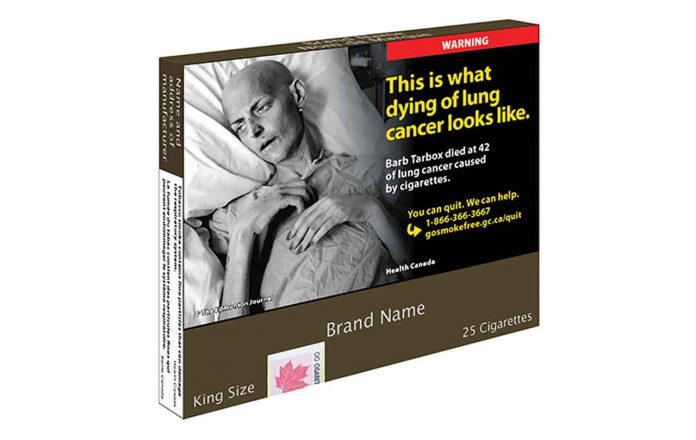THUNDER BAY – LIVING – In many ways it is hard to figure out smokers. All the medical research says smoking shortens your life, and causes health problems.
Over the past half century moves to discourage tobacco use have taken cigarette advertising out of newspapers, magazines, off television, and eliminated tobacco as a sponsor of concerts and sporting events.
Millions have been spent to discourage young people from smoking. One of the tools was putting very graphic images on cigarette packages showing the results of smoking or seeking to educate people.
Yet, the latest research from the United States shows that smokers who received cigarette packs with graphic warning labels simply hid their packs 38% more often. However, smokers stopped hiding their cigarettes when they returned to regular packs without the graphic labels.
This was the finding of a report by a multi-institutional group of public health experts led by University of California San Diego.
“In a randomized clinical trial, we demonstrated that smokers in the U.S. who received cigarettes in packs with graphic warning labels were less willing to display the packs in public. It has been hypothesized that this behavior could reduce perceptions by teens that it is socially acceptable to smoke, perhaps explaining why mandated graphic warning label packs are associated with reductions in teen smoking,” said first author John P. Pierce, Distinguished Professor at the Hebert Wertheim School of Public Health and Human Longevity Science at University of California San Diego.
In a paper published in the June 2, 2022 online issue of JAMA Network Open, Pierce and colleagues at UC San Diego Moores Cancer Center, California State University San Marcos and San Diego County Public Health Services manufactured special cigarette packs that incorporated graphic images of a diseased foot, a newborn with a breathing tube, or throat cancer on cigarette packs in Australia (under license from the Australian government).
Study participants included 357 smokers living in San Diego who agreed to purchase their preferred brand of cigarettes from a study website. Participants were randomized to receive their cigarettes in one of three pack designs: a package with a graphic warning label, with a blank pack, or in a standard commercially available U.S. pack. Approximately 19,000 packs were delivered to participants.
Graphic warning labels are used on cigarette packs in more than 120 countries. Despite being mandated by the U.S. Congress in 2009, implementation of graphic warning labels has been held up by legal challenges by the tobacco industry.
“Prior to the study, we found that many smokers in the U.S. were discrete and reported hiding their usual pack in public settings. The packs with graphic warning labels had their main effect on those who were least likely to hide their packs prior to the study,” said senior author David R. Strong, professor at the Herbert Wertheim School of Public Health. “We found no evidence that graphic warning-labeled packs changed smoking behavior over the year-long study.”
Individuals continued to smoke as often as they did before and after the study.
During the study, participants were asked, via interactive text messaging, if over the previous four hours they placed their packs where others would not see them. Changes in consumption and smoking status were assessed at the end of the three-month intervention and at the end of the 12-month study.
Participants who received cigarettes in a standard U.S. pack, or in a blank pack that had no marketing, did not change pack hiding behavior. Smokers randomized to the graphic warning label arm reported that they increased pack hiding over the first four weeks of the intervention and continued at the new level until the end of the intervention. After they stopped receiving the packs labeled with graphic warnings, they quickly reverted to baseline pack hiding levels.
When social reactions were queried at the end of the study, the group with graphic warning label packs reported that observers had aversive reactions to the cigarette packs while those in the blank pack group reported that observers expressed a positive interest in the study, said the authors.
Co-authors include: Sheila Kealey, Eric C. Leas, Matthew D. Stone, Jesica Oratowski, Elizabeth Brighton, all of UC San Diego; Kim Pulvers, CSU San Marcos; and Adriana Villaseñor, San Diego County Public Health Services.
This research was funded, in part, by the National Cancer Institute (RO1 CA190347, RO1 CA234539) and a Tobacco-Related Disease Research Program grant (28DT-0005).







